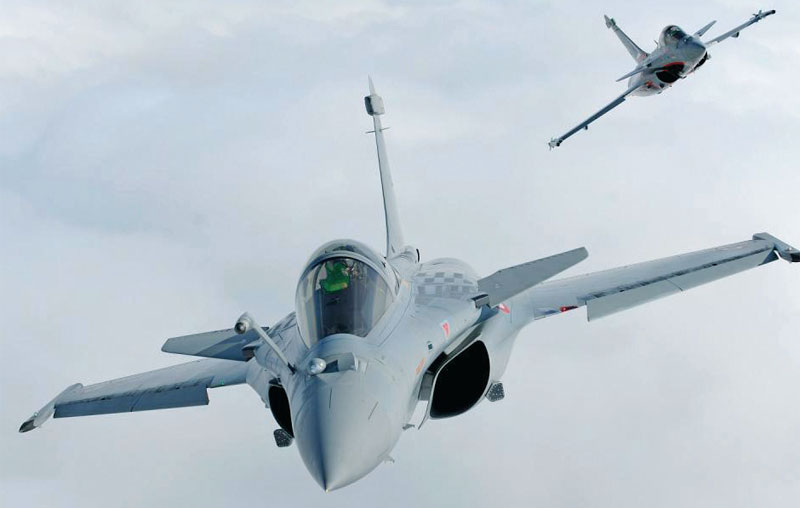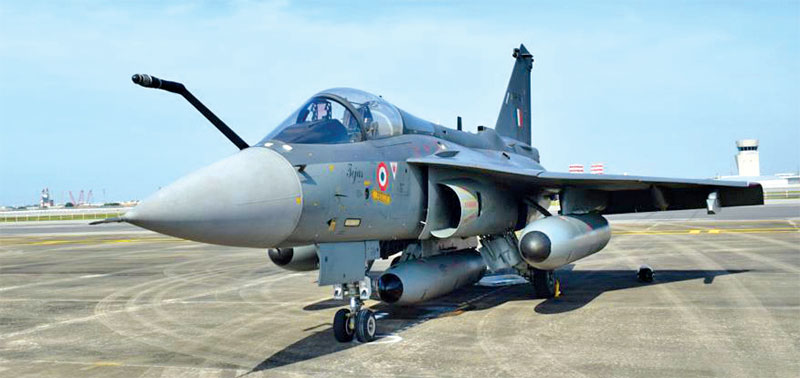Indigenous MRO set to fly with large engine orders for commercial aircraft, fighter jets, military helicopters
Atul Chandra
India is now in the midst of a major procurement cycle across commercial and military aviation resulting in large orders for aero engines. The recent orders by Air India and current and upcoming orders for fighter and helicopter engines are a bonanza for foreign OEMs. Air India’s aircraft orders are worth approximately USD 70 billion (at list prices) but how much of this value will translate back into the Indian aerospace ecosystem is a matter of conjecture.

Indian military aviation orders will also run into thousands of engines in the next two decades and presents an unmatched opportunity to gain deeper access into engine MRO. Typically, OEMs are amenable for Transfer of Technology (ToT) or Maintenance ToT (MToT) contracts during negotiations for the original contracts themselves and are unlikely to extend significant concessions once the deals are inked. This is all the more the case for engine MRO, which requires heavy investments and sustained work to keep engine shops operational and profitable.
New Direction
It is in the realm of fighter engines that a major change is under way with the Indian armed forces moving away from decades of investment in licence production and overhaul of Russian aero engines for its fighter aircraft, transport aircraft and helicopters. While Russia was considered as a trusted supplier, the greatest surprise it is the emergence of the US as the principal supplier of aero engines for India’s indigenous fighter programmes.
While the US is often criticised in many Indian quarters as being trigger happy when it comes to sanctions, the Indian defence establishment appears to believe that US engine supplies for domestic fighter programmes would be immune to any future threat of sanctions. The fact of the matter also is that despite decades of investment in the Kaveri engine programme, its failure has ensured that the current and next-generation of indigenously developed fighters will be powered by imported engines.
The Tejas Mk-1, Tejas Mk-1A and LCA Mk2 and future Twin-Engine Deck Based Fighter (TEDBF) all feature GE engines, with the former two already being powered by F404-GE-IN20 engines. GE Aviation had first received an order in 2004 for the purchase of 17 F404 engines to power a limited series of operational production aircraft and naval prototypes, followed by orders for 24 F404 GE engines in 2007, valued in excess of USD 100 million. The F404-GE-IN20 engines succeeded the F404-F2J3 development engines used for nearly 900 flights, cumulatively covering nine engines used in the Tejas development programme.
In October 2010, the Aeronautical Development Agency (ADA) selected the F414-GE-INS6, which was the highest-thrust F414 model to power the MkII version of the Light Combat Aircraft (LCA). GE Aviation was to supply an initial batch of F414-GE-INS6 engines with the rest to be manufactured in India under transfer of technology arrangement. The F414-GE-INS6 features Full Authority Digital Electronic Control (FADEC) and added single-engine safety features. The F414 is designed to maximize time-on-wing, simplify maintenance and keep life cycle costs low. Its six-module engine architecture is reliable, easy to maintain, and interchangeable with no scheduled overhauls and on-condition maintenance.
In August 2021, the Hindustan Aeronautics Limited (HAL) ordered 99 F404-GE-IN20 engines and support services engines for the Tejas Mk-1A Valued at USD 716 million. GE Aviation has committed to deliver all 99 engines and support services by 2029. Cumulatively, these amount to orders for 149 engines along with future orders for 99 more when the LCA MkII nears production. The F414-GE-INS6 engine has also been selected for the ADA’s TEDBF and with at least 45 aircraft needed by the navy and 4-5 prototypes, orders for an additional 200 engines are in the offing. All these engines will remain in service for the next three to five decades. With such a large number of engines powered indigenous fighters, the Indian defence establishment must ensure that the requisite in-country MRO infrastructure for these engines be created well in time.
Opportunity Calling
There will also be two large future engine orders for the Indian Air Force’s (IAF) 114 Multi-Role Fighter Aircraft (MRFA) and the Indian Navy’s 57 Multi-Role Carrier Borne Fighters (MRCBF). A decision to opt for the Rafale for both services (Rafale M (Marine) and Rafale F3-R) will result in total orders for 171 aircraft and over 340 engines. Coupled with the existing fleet of 36 Rafales with the air force, this will take the total order to 207 aircraft. With such a large engine order, India must negotiate to emerge as the regional MRO provider for Safran’s M88, which powers the Rafale.
The M88 engine is the successor to Safran’s M53, which powers the IAF’s Mirage 2000s and the former has accumulated over 8,50,000 flight hours. The M88 is operational with the air forces of France, Egypt, Qatar, India, Greece and Croatia. To meet the surging demand for the Rafale, Safran was able to triple annual production of the M88 from 2015 to 2020, driven by Industry 4.0 practices and a fully automated assembly line. Over 600 M88 engines have been delivered to date. A navy decision to opt for Boeing’s F/A-18E/F Block III Super Hornet will result in orders for nearly 120 GE F-414 engines, which are the same family of engines selected for the LCA MkII and the TEDBF.
It is important for both the air force and navy requirements that strong efforts are made to create a high-level engine MRO infrastructure in India, which will serve the armed forces till 2060. Arguably, there is a greater need for the creation of an in-country engine MRO infrastructure rather than manufacturing technology transfer for these engines.
Rotary Wing Revolution
The agreement by Safran Helicopter Engines and the HAL on a workshare agreement for the joint development of the engine intended for the future 13-ton IMRH (Indian Multi-Role Helicopter) and its naval version DBMRH (Deck Based Multi-Role Helicopter) at the recently-concluded AeroIndia was welcome news indeed. One would hope that the HAL also pushes for unprecedented levels of MRO access for these engines.
Both companies had entered into a Memorandum of Understanding (MoU) in July 2022 with the HAL now having the opportunity to take part in the design, development and production of some of the core engine components, which can be considered a breakthrough achievement in terms of expertise and know-how in the country. C.B. Ananthakrishnan of the HAL stated: “The joint development of high power engine is a new milestone in the HAL’s ever-growing capabilities in the sector with a competent partner like Safran Helicopter Engines. We are confident of making the engine meet the highly stringent and demanding requirements of Indian defence customers.” Both companies have also agreed on the condition for the transfer right to the HAL for manufacturing of seven critical forging and casting raw parts for further enhancement of indigenous content in the Shakti engine of Dhruv and Light Combat Helicopter (LCH) programmes.
The HAL already has a longstanding partnership with Safran Helicopter Engines for the joint development and production of the Shakti engine, which powers newer variants of the Dhruv helicopter (MkIII and Mk IV) in addition to the Light Combat Helicopter (LCH). More than 500 Shakti engines have been produced in India by the HAL and Safran Helicopter Engines. There are also over 1,000 Safran-designed helicopter engines in service with the Indian armed forces, including the legacy Artouste engines, which power the Cheetah and Chetak helicopters.

Missed Opportunity
Air India’s recent order for 210 Airbus A320/321 Neos, 40 Airbus A350s, 190 Boeing 737 MAXs, 20 Boeing 787s, 10 Boeing 777-9s is a once in a generation aircraft order. Once the bulk of these aircraft are inducted by the end of this decade, it will provide economies of scale for engine MRO to be undertaken in India for these powerplants. However, the decision to create the engine shop capability in all likelihood must be made in the next few years.
The Air India order includes more than 800 CFM LEAP engines (420 LEAP-1A and 380 LEAP-1Bs, plus spares) to power its entire narrowbody purchase of 210 Airbus A320/A321neo aircraft and 190 Boeing 737 MAX-family aircraft. This was CFM International’s largest LEAP order ever and included a multi-year CFM services agreement. The other beneficiaries of Air India’s order were GE Aviation, which received a firm order for 40 Genx-1B and 20 GE9X engines, plus a multi-year TrueChoice engine services agreement, and Rolls-Royce which bagged orders for 68 Trent XWB-97 engines.
CFM International’s LEAP-1A engines are an engine option on Airbus’ A320neo aircraft family, while its LEAP-1B engines are the sole powerplant on Boeing’s 737 MAX jetliner. CFM is a 50/50 joint business between GE and Safran Aircraft Engines. General Electric’s GEnx and the Rolls-Royce Trent 1000 are the two engine options available for the widebody 787. The A350 and Boeing 777X, however, have Rolls-Royce’s Trent XWB and General Electric’s GE9X respectively as their sole powerplants. CFM is having a tremendously successful run in India, with engine orders well over the 2,000 unit mark. In addition to Air India’s order for 800 CFM LEAP engines, IndiGo has nearly 1,200 CFM LEAP engines on order and Akasa Air has 144 more.
As is evident from the above, India’s aviation ecosystem now has the economies of scale required to establish engine MRO facilities in the country. This is an opportunity that must not be missed.

